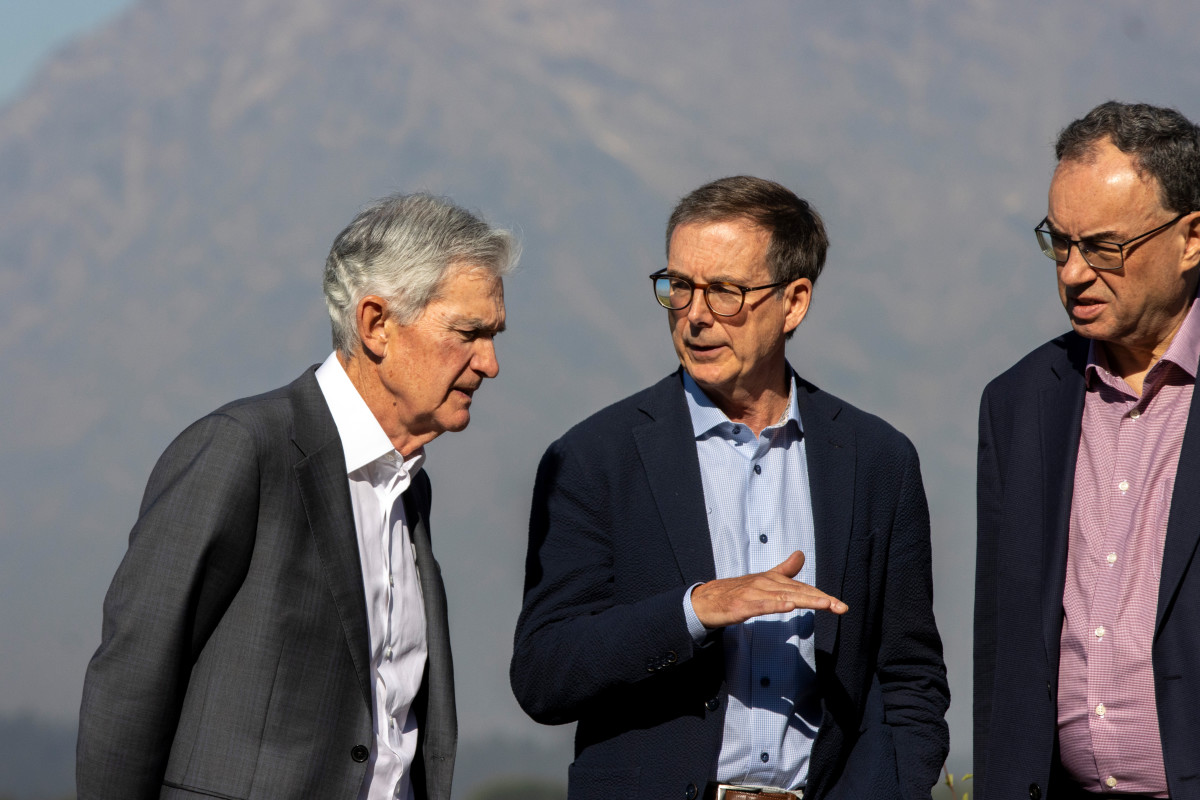In 2024, falling inflation and steady job gains gave Fed Chair Jerome Powell room to stay patient.
Not this year.
??Don’t miss the move: Subscribe to TheStreet’s free daily newsletter??
Just ask your wallet. Or your credit-card bills.
The world’s most influential central bankers are gathering in Wyoming this week for the 2025 Jackson Hole Economic Symposium.
The economic stakes are far more complicated than a year ago.
There’s also a pivotal political one: the independence of the Fed Reserve, the world’s largest and most influential central bank.

Image source: Bloomberg/Getty Images
This year’s Jackson Hole conference topic couldn’t be timelier
For now, all eyes remain on Powell’s speech on Friday, with markets braced for a defining Fed signal heading into the FOMC September meeting.
This year’s Jackson Hole topic is “Labor Markets in Transition: Demographics, Productivity, and Macroeconomic Policy.”
With leaders from the European Central Bank, Bank of England, and Bank of Japan in attendance, Jackson Hole once again offers a stage where subtle policy signals could rip through global markets.
Related: What the star-studded Jackson Hole economic meeting means to you
Sponsored by the Federal Reserve Bank of Kansas City, the annual symposium is one of the longest-standing, invitation-only central banking conferences in the world.
It takes place Aug. 21-23. In a typical year, around 120 people attend.
Economists, financial market participants, academics, U.S. government representatives, and news media are selected based on each year’s topic.
All symposium participants, including members of the press, pay a fee to attend. The fees are then used to recover event expenses.
Since the event remains tightly controlled and fee details are not broadcast, attendees must cover both the event fee and their own travel and lodging.
Key areas where this year’s Jackson Hole conference will differ from 2024
Inflation 2024 vs. 2025: CPI was trending down last year toward the Fed’s 2% goal, easing pressure. This year inflation’s steady, but costs are rising.
The Consumer Price Index held at 2.7% in July, while core inflation ticked up to 3.1%.
Meanwhile, wholesale prices surged: The Producer Price Index is up 0.9%, the biggest jump since 2022.
This is pushing fears that tariffs are reigniting cost pressures through the supply chain and onto businesses and consumers.
Related: Jobs report shocker resets Fed interest rate cut bets
Labor Market 2024 vs. 2025: Hiring remained strong last year with unemployment below 4%. This year, the labor market is softening with revised numbers.
Employers added just 73,000 jobs in July, while downward revisions erased more than 250,000 positions from earlier months.
The unemployment rate rose to 4.2%, the weakest pace of hiring since 2010 outside the pandemic.
“The PPI shock complicates the Fed’s path,” said KPMG Chief Economist Diane Swonk. “Rate cuts are on the table, but the inflation stickiness makes a big move risky.”
Monetary policy: In 2024, Powell was cautious but optimistic, signaling patience on cuts. This year, stagflation risks emerge again.
Analysts warn this could trap the Fed between supporting employment and containing inflation.
“The Fed’s dual mandate — stable prices and maximum employment — is pulling in opposite directions,” said Moody’s Analytics Chief Economist Mark Zandi. “If they cut too soon, inflation could flare up. If they hold too long, job losses could deepen.”
Jerome Powell’s keynote to focus on rate cut
Markets will focus on Powell’s keynote Aug. 22, as he weighs whether the Fed can pivot toward rate cuts without fueling price instability. His speech will also reflect the Fed’s evolving policy framework.
Fed officials are split.
Some, citing economic fragility, urge a rate cut to shore up the labor market.
Others argue that inflated prices, especially porous tariffs and service-sector pressures, require caution before easing policy.
Will Fed Chair Powell pivot?
Analysts suggest Powell’s speech may temper market optimism, carefully calibrating expectations rather than igniting them.
He may signal a data-dependent approach and acknowledge the labor-market softness without committing to a rate-cut trajectory.
Investors and global policymakers will scour for clues as to whether the Fed will lean dovish enough to spur easing when it meets Sept. 17.
It could also be hawkish in the face of sticky inflation and maintain its “wait-and-see’’ approach to holding the Federal Funds Rate steady at 4.25% to 4.50%.
More Federal Reserve:
- GOP plan to remove Fed Chair Powell escalates
- Trump deflects reports on firing Fed Chair Powell ‘soon’
- Former Federal Reserve official sends bold message on ‘regime change’
With markets already sensing an easing cycle, Powell’s tone could either sustain the rally or trigger volatility.
“Powell could illustrate how the central bank will have to prioritize one of the Fed’s dual mandates over the other as labor markets cry out for lower short-term interest rates, but inflation is suddenly asking for more caution,’’ TheStreet Pro’s veteran trader Stephen Guilfoyle wrote Aug. 18.
“Powell could also discuss changing the Fed’s approach to fighting inflation and simply working toward a target instead of trying to average a target rate over time,” he added.
Further complicating matters: Powell may need to defend the Fed’s independence amid political pressure especially from President Donald Trump, who is reportedly considering successors for him.
There’s an 83.2% probability that the Federal Open Market Committee will cut rates 0.25% at its September meeting, according to the CME Group’s FedWatch tool.
Related: White House taps more potential candidates to head the Federal Reserve
#Expect #fiery #outcomes #Feds #Jackson #Hole #conference #week